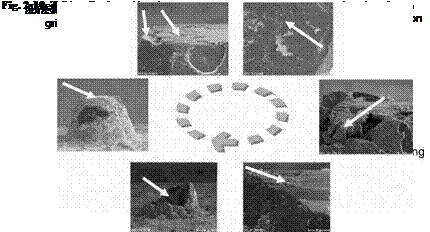Not only the workpiece, but also the tool is subjected to high temperatures and pressures in the contact zone. The result of this is microscopic wear in the grit and the bond (Fig. 2-12).
Grit wear begins in the crystalline layers lying near the surface of the grit. Extreme pressures and temperatures initiate oxidation and diffusion processes there, which decrease the abrasion resistance of the grit material. This pressure-softened layer is removed by mechanical agitation (abrasion). In this way, new crystalline

layers are constantly exposed to wear. By means of tribochemical reactions on the grit surface, the mechanical endurance of the grit can change, intensifying wear.
Moreover, mechanical and thermal alternating stress can lead to fatigue in the crystal bond. At points of disruption, which exist in every solid body in the form of lattice and grain boundaries, impurities, differences in hardness etc., cracks of fatigue appear. These can lead to disintegration of the surface as well as to the splitting off of individual grain particles or initiate the formation of cracks that cause entire sections of grit to break off.
In many cases, grit wear is the indirect cause for bond wear, since a flattening of the cutting edge of the grit leads, due to an enlarged friction surface, to an increase in cutting force on the individual grit and thus to mechanical overloading of the bond. Entire grits or grit sections can then break out of the bond. The bond can also be directly worn by chemical, mechanical or thermal influences.
Such causes of wear are to be considered in process design and particularly in the choice of grinding wheel specifications.
